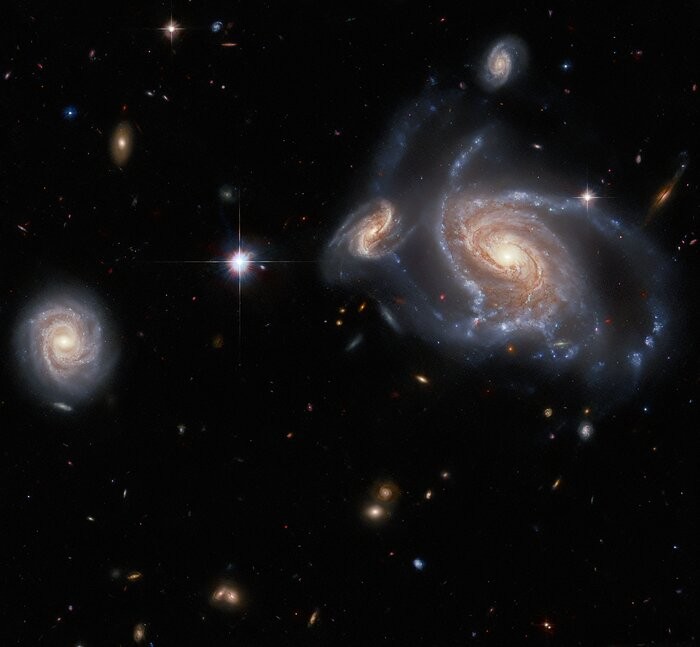The European Space Agency (ESA) has recently released an image captured by the iconic Hubble Space Telescope that provides an enthralling depiction of a gathering of spiral galaxies.
The image accentuates multiple unique galaxies, each with distinctive features that enrich the cosmic canvas.

The Hubble Picture of the Week from the European Space Agency (ESA) features a treasure trove of spiral galaxies with NGC 1356 commanding the right side, accompanied by LEDA 467699 (above) and LEDA 95415 (to its left). Completing the cosmic display, IC 1947 graces the left side. The intricate details of these galaxies unfold, providing a captivating glimpse into the celestial expanse captured by the Hubble Space Telescope.
An Abundance of Spiral Galaxies
Taking center stage in this cosmic assembly is the NGC 1356, a sizable spiral galaxy that commands attention on the right side of the visual composition.
Positioned alongside NGC 1356 are two seemingly smaller spiral companions, identified as LEDA 467699, which was located above, and LEDA 95415, positioned closely to its left. IC 1947, elegantly situated along the left side of the celestial image, concludes the quartet of galaxies.
The visual spectacle presented in this Hubble image is a testament to our cosmic neighborhood's vast diversity and intricate structures. The large spiral galaxy on the right showcases its sprawling, twisted arms, while the smaller spirals on the left contribute their detailed features.
A fourth, round spiral galaxy, seen face-on, graces the right side of the composition. Amid these galaxies lies a solitary bright star, adding a touch of brilliance to the cosmic tableau, and in the background, distant galaxies and stars punctuate the cosmic canvas.
The Challenge With Spatial Relationships
However, according to ESA, interpreting the spatial relationships between these celestial objects is not without challenges. The two-dimensional nature of the image provides only an indication of angular separation, the apparent spread across the night sky.
Hence, the space agency noted that it can be misleading when assessing the accurate distances between objects. NGC 1356, LEDA 467699, LEDA 95415, and IC 1947 may give the impression of being closely situated in the image, hinting at potential cosmic camaraderie. However, the vast cosmic expanses unveil a different reality.
Read Also: NASA Hubble Discovers Saturn's Ring System Heats Planet's Atmosphere-A Never-Before-Seen Phenomenon!
Separated by 300 Million Light-Years
Despite the apparent proximity, the NGC 1356 and LEDA 95415 are separated by nearly 300 million light-years. Despite its visual size, the latter does not exhibit as much diminutiveness compared to NGC 1356 when considering their actual distances from Earth.
On the flip side, the seemingly distant positioning of NGC 1356 and IC 1947 in the image reveals that they are much closer cosmic neighbors in three-dimensional space.
Although the angular separation appears noteworthy, the actual distance between them is less than four hundred thousand light-years, underscoring the intricate interplay of perspective and distance in cosmic observations.
Related Article: NASA's Hubble Space Telescope Captures 'Butterfly Nebula' In Stunning Motion | Fun Facts About This Beautiful Space Butterfly










